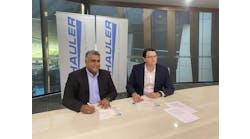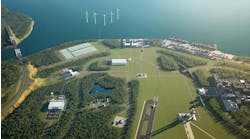For much of the past decade manufacturing industry’s focus has been on stripping inventory out of the supply chain, aided to a great extent by its investment in ERP. Now Wonderware president and CEO Sudipta Bhattacharya told journalists attending Wonderware UK’s Xchange 2008 user conference in the slightly surreal surroundings of Alton Towers, supply chains are leaner and, inevitably, more fragile, and there is a need to connect directly into the plant. Speaking over a video link from Invensys Process Systems’ Plano, Texas, headquarters he said, “There’s a resurgence of focus on the plant,” which perhaps explains his own August 2007 move to Wonderware from SAP and his subsequent succession to Mike Bradley as president and CEO just 12 months ago.
That shift in emphasis from supply chain to plant leaves Wonderware better placed than any of its SCADA or MES software rivals, he argues. “Most solution providers are a mix of software and hardware suppliers and the software is almost an afterthought,” he explained. “The fact that we are hardware-agnostic provides an opportunity for us. It changes the sales philosophy, and it means that we can talk to a customer at a different level.”
But doesn’t that shift in emphasis back towards the plant floor also mean that enterprise software providers such as SAP and Oracle will themselves start to move down into the MES space? That’s certainly what the Xchange presentation from Simon Pollard, SAP’s European vice president of manufacturing operations and execution, seemed to imply with an emphasis on the “Make” phase of the overall manufacturing supply chain, and a PowerPoint slide that showed SAP MII (Manufacturing Integration & Intelligence) interfacing directly with Level 2: Automation and Connectivity and Level 1: Shop Floor and Process Control.
“Absolutely,” agreed Bhattacharya, but Wonderware’s big area of strength is in the supervisory or real-time platform and in what he calls “the Wonderware ‘ecosystem’ of 60 distributors and more than 3000 integrators and developers.” It’s that ecosystem which gives Wonderware the domain expertise in specific vertical industrial sectors that a SAP or an Oracle can’t match. “From our perspective, we understand the plant floor really, really well. At the same time, software is becoming more and more complex and customers are looking to obtain it all from one vendor. So we are confident of our strengths.”
Taking market share
That’s why Wonderware, he claimed, is continuing to take market share away from its direct competitors at a rate of between 1% and 1.5% a year, giving it a current global market share, by his reckoning, of between 22% and 23%. Can that continue as the signs of recession begin to multiply? Bhattacharya believes Wonderware is well-placed to withstand any downturn because of the diversity of its markets―even its largest, food & beverage, accounts for only 18% of its total revenues―and its huge installed base of 550,000 licenses across 125,000 plants worldwide. “Recession will matter less to us than to our competitors,” said Bhattacharya. “Customers will continue to spend on applications rather than on hardware. The return is very quick, and that helps us in recession. Indeed it may even create an opportunity to take market share at a faster rate.” As to the immediate impact of the current financial turmoil, “The whole thing has happened so quickly that it’s hard to see what it will be. So far projects are being pushed out, but companies still have the money.”
The size and diversity of the installed base is also the key to Wonderware’s future growth, creating the opportunity to grow through repeat customer business while continuing to extend the range of industries served, most notably by diversifying into infrastructure and large facilities management applications including airports and mass transit systems, such as London Underground. But the ambition goes further than merely extending the installed base. “What is our grand vision?” asks Bhattacharya. “We want to be the company that empowers the production worker.”
Productivty plateau?
Has the productivity growth of recent years now reached a plateau? There’s no reason to think so, he believes, and the next generation of solutions from Wonderware will ensure that it doesn’t. “The plant floor has the largest density of ‘untapped’ workers. That’s why three quarters of additional users (of our software) are in existing plants.” Meeting their needs, however, will require continued development and, where necessary, acquisitions. “Our ambition and hope is to continue to enhance the platform,” he says, citing the recent acquisition of SAT and with it the IntelaTrac mobile worker solution as an example for which Wonderware has ambitions that go well beyond its current applications in maintenance.
And what of the relationship with IPS, of which it is both a part for reporting purposes, but from which it continues to maintain an apparent separation? Bhattacharya himself lives in Dallas, is based at IPS’ Plano headquarters and says that “the relationship gets stronger and stronger.” Not only is InFusion “a lot of Wonderware” but IPS has “started seeing the benefit of our having integrators that it can leverage.”
And there are wider synergies, he says, which will enable IPS as a whole to have a wider footprint on the plant floor. “The strength lies in the differences, in the coexistence of two business models with Wonderware going into much smaller plants than IPS can.”
Wonderware’s product strategy for MES (Manufacturing Execution Systems) and EMI (Enterprise Manufacturing Integration) was outlined to Xchange delegates by Niels Andersen who rejoices in the title of “Director of Product Definition.” The aim, he explained, is to develop a portfolio of solutions based on a common set of components and services, some of which would be originated by Wonderware, some by partners and some by the customers themselves. As a result, rather than having to purchase capabilities they do not require, users will be able to add functionality only when it is needed.
While the concept sounds simple, its implementation rapidly become complex and poses the problem of how to migrate existing users of legacy applications to the new world of objects and models. Similarly, while the full power of the approach will prove invaluable in addressing the needs of large users with complex requirements, the overhead it imposes could prove disproportionate to the simpler and less complex needs of Wonderware’s many smaller users.
Parallel routes
The result is in effect parallel routes for the two classes of users. For example, power users can take the full-blown model-based approach embodied in Wonderware Operations and Wonderware Performance, while the option of the Equipment Operations Module (EOM) is retained for users who only require the capture of production history and event data. EOM doesn’t require a model and so potentially involves less engineering to get started and effectively represents a simple extension of the basic supervisory system. However, it still gives users the option at a later date of migrating to Wonderware Operations and Wonderware Performance through the transfer of EOM objects without have to go back to square one.
Longer-term, the strategy is to develop the MES capability as an extension of System Platform, with an Operational Collaboration Platform, an Operational Execution Platform and an Operations Intelligence Platform layered on top of System Platform.
Specific products previewed by Andersen in his Product Roadmap include Wonderware System 3.1 offering, such enhancements as improved integration with Wonderware Historian, more flexible alarm handling and enhanced time-stamp propagation. The new release will also be “Multi Core Ready” and will support .NET 3.0. The companion InTouch 10.1 will offer enhanced ArchestrA-based graphics with facilities such as interactive animation and thumbnail previews, new controls, dynamic language switching and dynamic properties linking and enhanced self documentation.
Perhaps most significant, given the importance Sudipta Bhattacharya assigns to domain expertise, next year will see specific packages tailored to the needs of the water and wastewater, packaging and facilities management industries while 2010 will see offerings for energy management, metals and mining and oil and gas.



